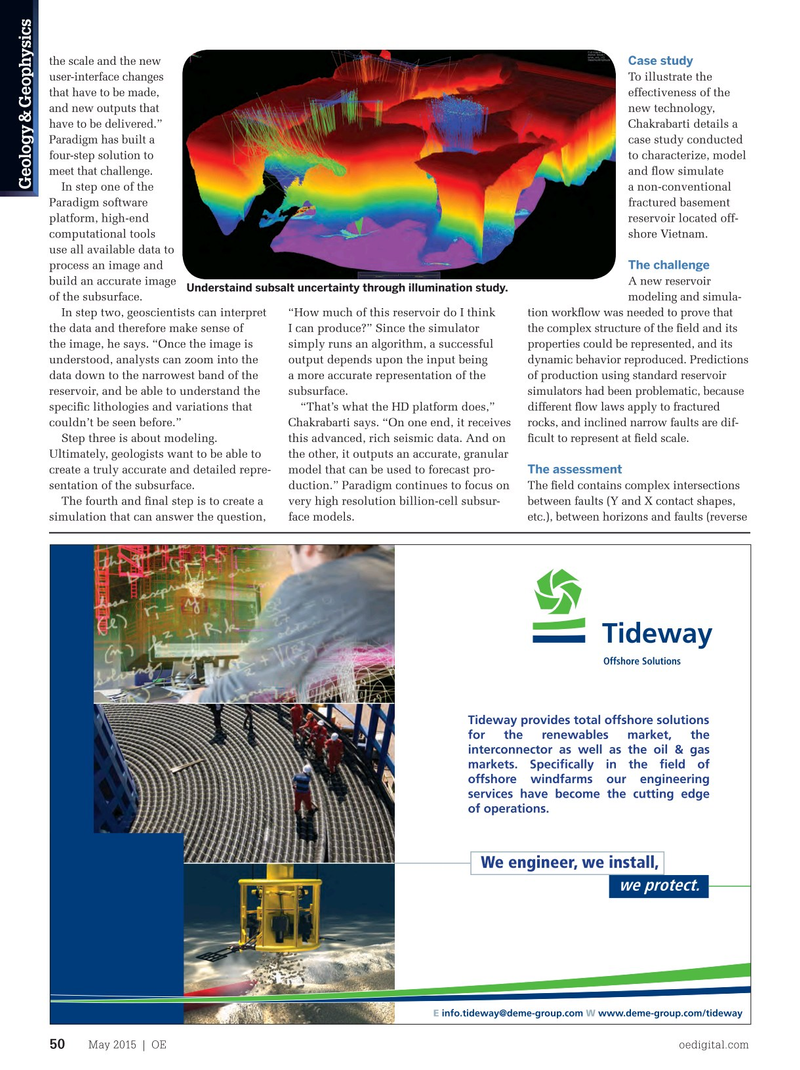
Page 48: of Offshore Engineer Magazine (May/Jun 2015)
Read this page in Pdf, Flash or Html5 edition of May/Jun 2015 Offshore Engineer Magazine
the scale and the new Case study faults, important offset of the basement
To illustrate the on the fanks) and between horizons user-interface changes effectiveness of the (converging small angle contacts between that have to be made, new technology, the top of the basement and the sedi- and new outputs that
Chakrabarti details a ments lying on its fanks). Since results have to be delivered.” case study conducted to date using standard tools had not been Paradigm has built a to characterize, model suffcient, the decision was made to use four-step solution to and fow simulate Paradigm SKUA modeling software to meet that challenge.
Geology & Geophysics a non-conventional In step one of the build a structural framework model that fractured basement Paradigm software properly honors fault intersections. platform, high-end reservoir located off-
The solution computational tools shore Vietnam.
use all available data to For this project, only a sector scale model
The challenge process an image and (12.5km by 4.5km) was studied. A total
A new reservoir build an accurate image of 53 original fault interpretations were
Understaind subsalt uncertainty through illumination study.
modeling and simula- of the subsurface. included and no faults were excluded tion workfow was needed to prove that “How much of this reservoir do I think In step two, geoscientists can interpret when modeling the data with the SKUA the complex structure of the feld and its
I can produce?” Since the simulator the data and therefore make sense of system. Faults were loaded as fault sticks properties could be represented, and its simply runs an algorithm, a successful the image, he says. “Once the image is from an ASCII fle. dynamic behavior reproduced. Predictions output depends upon the input being understood, analysts can zoom into the Most of the faults had not been assigned of production using standard reservoir a more accurate representation of the data down to the narrowest band of the any throw type, mainly because their simulators had been problematic, because subsurface. reservoir, and be able to understand the throw was too small to make a decision. different fow laws apply to fractured “That’s what the HD platform does,” specifc lithologies and variations that Some faults were identifed as reverse, rocks, and inclined narrow faults are dif-
Chakrabarti says. “On one end, it receives couldn’t be seen before.” about 10 others were identifed as normal. fcult to represent at feld scale. this advanced, rich seismic data. And on Step three is about modeling. This extra information was used as a con- the other, it outputs an accurate, granular Ultimately, geologists want to be able to straint in the SKUA modeling process.
The assessment model that can be used to forecast pro- create a truly accurate and detailed repre- The top basement interpretation was
The feld contains complex intersections duction.” Paradigm continues to focus on sentation of the subsurface. loaded as a CPS3 regular 2D grid (resolu- between faults (Y and X contact shapes, very high resolution billion-cell subsur- The fourth and fnal step is to create a tion 25m by 50m). The interpretation of etc.), between horizons and faults (reverse face models. simulation that can answer the question, the top of the sediment contained points
Tideway provides total offshore solutions for the renewables market, the interconnector as well as the oil & gas markets. Specifcally in the feld of offshore windfarms our engineering services have become the cutting edge of operations.
We engineer, we install, we protect.
E [email protected] W www.deme-group.com/tideway
May 2015 | OE oedigital.com 50 048_OE0515_G&G2_Paradigm.indd 50 4/19/15 11:59 PM

 47
47

 49
49